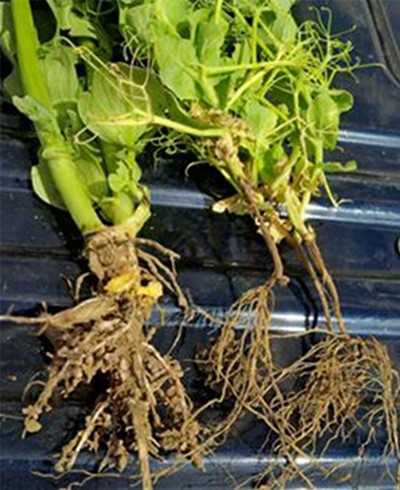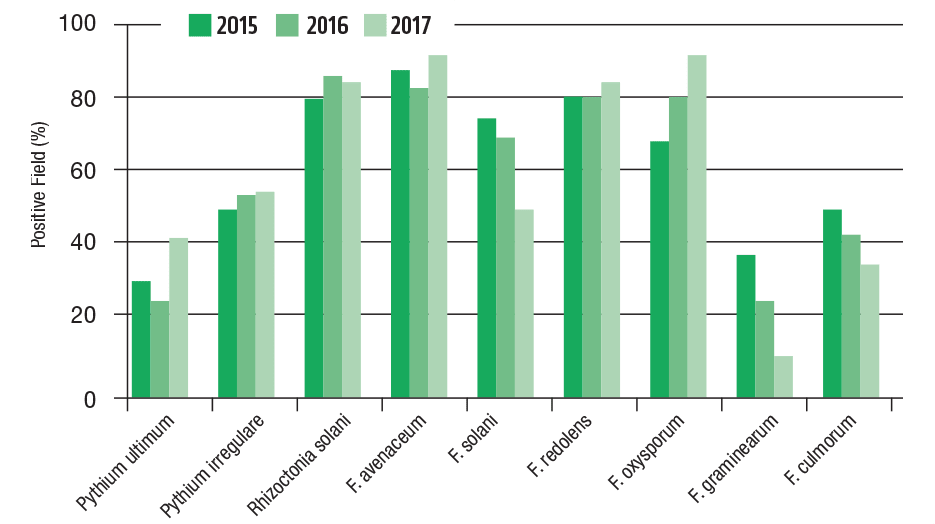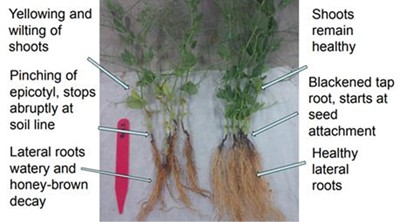Getting to the Root of the Problem

Root rot and clubroot are two serious diseases which can, at best, cause yield losses and, at worst, cause premature plant death. While clubroot is a disease solely affecting brassica crops, such as canola, root rot can take hold in cereals, pulses, canola and other field crops when conditions are right and pathogens present.
Managing these diseases can be challenging and require a multi-pronged approach that includes planting disease-resistant seed, longer crop rotations, fungicide application and vigilant scouting. OMEX has a wide range of products that can be used concurrently with your root rot and clubroot management tactics to promote robust, healthy roots, mitigate plant stress and correct nutrient deficiencies throughout the growing season.
The image on the right shows the difference in early-season growth and development between a root rot-infect plant (left) and a healthy plant (right).
Let’s get to the root of the problem, shall we?
Root Rots
Soil- and seed-borne diseases responsible for root rots in many Prairie crops are increasingly becoming threatening. These rots are caused by various species of Pythium sp., Rhizoctonia sp., Fusarium sp., Phytophthora sojae and Aphanomyces euteiches (Fig. 1). Their impact on early-season establishment, growth and development is significant and will translate into yield losses at harvest. That is, if the crop manages to grow at all.

Each root rot has characteristic symptoms and manifests in the crop under specific soil and moisture conditions. Proper diagnosis allows for the identification of the main cause of root rots; however, in many instances, multiple pathogens co-exist making the diagnostic difficult to the less-experienced eye.


When scouting for root rot, pulling plants and checking the symptoms on the roots and shoots can be very revealing. For instance, the appearance of yellowing and wilting of the shoots on peas alongside the pinching of the epicotyl and watery lateral roots characterize Aphanomyces infection. However, when the shoots remain somewhat green in color while the tap root turns dark with healthy lateral roots, the crop is likely infected with Fusarium (Fig. 3).
Clubroot
In the last few years we have also seen a surge of clubroot in canola caused by Plasmodiophora brassicae. Clubroot is a soil-borne disease that causes the roots of the affected plant to develop swollen, club-like galls which can ultimately lead to premature death of the plant.
The most effective methods of controlling clubroot are through a combination of scouting and record keeping, sanitation, crop rotation, soil amendments and planting resistant varieties.
Clubroot is devastating, especially in acidic soils with low levels of calcium and boron. In addition, tight rotations with canola, or growing the crop back-to-back, can cause the disease to spread and the pathogen to evolve new pathotypes that are constantly overcoming the introduced resistances bred in the new varieties.
One of the reasons clubroot is such is a serious disease is the longevity of the resting spores, which can survive in the soil for up to 20 years. It’s possible for the resting spores to become inactive or non-viable after a two year break from a host crop; however, clubroot thrives on other brassica weeds in canola fields (e.g., volunteer canola, mustard, stinkweed and flixweed), making a 2–3 year rotation alone insufficient for disease control. Good weed control is therefore a must, whether growing canola or alternative crops.
OMEX Can Help
Management of clubroot and root rot is challenging and relies on the use of an integrated approach: using resistant varieties, when available; allowing longer rotation, when economics permit; applying a seed treatment, when available; and employing herbicides or fungicides, when appropriate. As well, keeping a balance between macronutrients, secondaries and micronutrients and supplying key nutrients (e.g., potassium, calcium, boron, manganese, zinc, copper, sulfur) can help prevent deficiencies, promote resilience to stress, and help keep the crop as healthy as possible.
Here are some ways OMEX products can be used throughout the growing season, as part of a root rot and clubroot management strategy:
Get Primed for the Season – OMEX has developed a wide range of seed dressings called Primers (Primer Zn, Primer Mn, Primer Cu, Pulse Primer, Primer Canola, Pulse Pak, Primer Soybeans). Each is specifically designed to meet the needs of the crop, to optimize micronutrient uptake and maximize seedling emergence and vigor. Robust and healthy roots, along with earlier plant maturity, are just two of the numerous advantages to using a Primer.
Perfuze the Situation – OMEX offers a new line of products called Perfuze, which allows your ag retailer to coat every granule of your dry fertilizer blend with essential micronutrients, to address crop removal and replenish soil levels for subsequent crops. With variable liters per metric ton, depending on yield targets and fertilizer rate, OMEX has developed a calculator to help dealers and farmers address zinc, copper, manganese, iron, boron and magnesium independently or together to promote crop health.
Start Stronger – If you have a liquid kit on your drill, consider using Starter P fertilizer, available with various additives to address crops’ specific needs in The First 30 Days®. One of the advantages of choosing a liquid Starter fertilizer is the ability to strategically place phosphorus, potassium and key micronutrients close to seed, improving emergence and compensating for the lack of availability of these nutrients due to cold and wet soil conditions.
Mitigate Stress – When the crop reaches the 3-5 leaf stage and is ready to receive herbicide application, many indicators of biotic and abiotic stress become visible. To help alleviate stress and correct deficiencies, a whole suite of Foliars with NPKs, micronutrients and Stress Reliever Technology™ are available for use in the same spray tank (C3, Nutri-Boost, P3, Zintake w/SRT).
Correct Nutrient Deficiencies – Once herbicide timing has passed, Foliars can be applied alone or in conjunction with fungicides or insecticides to correct nutrient deficiencies or bridge the gaps caused by the inability of soil to transfer nutrients under a variety of stress conditions.
Talk to your OMEX representative today for more information about a guided nutrient management plan designed to help you meet your cropping goals. Be sure to ask about our new PGRs, Biostimulants and Biologicals – designed to promote crop health, growth and development.
